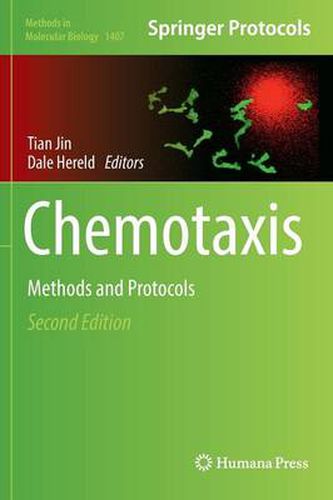Readings Newsletter
Become a Readings Member to make your shopping experience even easier.
Sign in or sign up for free!
You’re not far away from qualifying for FREE standard shipping within Australia
You’ve qualified for FREE standard shipping within Australia
The cart is loading…






This title is printed to order. This book may have been self-published. If so, we cannot guarantee the quality of the content. In the main most books will have gone through the editing process however some may not. We therefore suggest that you be aware of this before ordering this book. If in doubt check either the author or publisher’s details as we are unable to accept any returns unless they are faulty. Please contact us if you have any questions.
This second edition expands on the first edition with new chapters describing methods for studying cell movement, molecular components involved in chemotaxis, spatiotemporal dynamics of signaling components, and quantitative modeling, as well as several updated chapters from the first edition. Various methods to investigate directional cell growth and movements are presented in Chapters 1-20. These chapters contains experimental procedures to visualize and measure migration behaviors of different kinds of organisms, including chemotropism in the budding yeast; cell growth and migration of D. discoideum; border cell migration in Drosophila; chemotaxis of mouse and human neutrophils; and HIV-induced T cell chemotactic response. Chemotaxis: Methods and Protocols, Second Edition also contains microscopy procedures for studying breast cancer cell migration, tumor cell invasion in vivo, and axon guidance. The book concludes with Chapters 21-27 describing methods that measure spatiotemporal dynamics of signaling components involved in chemotaxis; introduce imaging techniques, such as TRIF, BRET, FRET, and single-molecule microscopy; and mathematical models of experimentally generated chemoattractant gradients. Written in the highly successful Methods in Molecular Biology series format, chapters include introductions to their respective topics, lists of the necessary materials and reagents, step-by-step, readily reproducible laboratory protocols, and tips on troubleshooting and avoiding known pitfalls.
Cutting edge and thorough, Chemotaxis: Methods and Protocols, Second Edition is a valuable resource for anyone who is interested in the diverse methodologies that are propelling chemotaxis research forward.
$9.00 standard shipping within Australia
FREE standard shipping within Australia for orders over $100.00
Express & International shipping calculated at checkout
This title is printed to order. This book may have been self-published. If so, we cannot guarantee the quality of the content. In the main most books will have gone through the editing process however some may not. We therefore suggest that you be aware of this before ordering this book. If in doubt check either the author or publisher’s details as we are unable to accept any returns unless they are faulty. Please contact us if you have any questions.
This second edition expands on the first edition with new chapters describing methods for studying cell movement, molecular components involved in chemotaxis, spatiotemporal dynamics of signaling components, and quantitative modeling, as well as several updated chapters from the first edition. Various methods to investigate directional cell growth and movements are presented in Chapters 1-20. These chapters contains experimental procedures to visualize and measure migration behaviors of different kinds of organisms, including chemotropism in the budding yeast; cell growth and migration of D. discoideum; border cell migration in Drosophila; chemotaxis of mouse and human neutrophils; and HIV-induced T cell chemotactic response. Chemotaxis: Methods and Protocols, Second Edition also contains microscopy procedures for studying breast cancer cell migration, tumor cell invasion in vivo, and axon guidance. The book concludes with Chapters 21-27 describing methods that measure spatiotemporal dynamics of signaling components involved in chemotaxis; introduce imaging techniques, such as TRIF, BRET, FRET, and single-molecule microscopy; and mathematical models of experimentally generated chemoattractant gradients. Written in the highly successful Methods in Molecular Biology series format, chapters include introductions to their respective topics, lists of the necessary materials and reagents, step-by-step, readily reproducible laboratory protocols, and tips on troubleshooting and avoiding known pitfalls.
Cutting edge and thorough, Chemotaxis: Methods and Protocols, Second Edition is a valuable resource for anyone who is interested in the diverse methodologies that are propelling chemotaxis research forward.